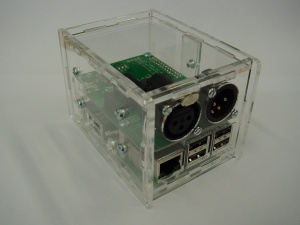Dmx interface for raspberry pi
Introduction
The DMX interface for raspberry pi allows you to interface a raspberry pi with DMX hardware.
There is also a version "with FT245" That version adds the option to use your raspberry pi with our board as an Enttec USB Pro compatible device from another computer (raspberry pi or PC, Windows or Linux)
If you select "for pi zero" we give you an extra 40 pin male header and do not solder the matching female header onto our board. You can then chose several configurations yourself. The one I prefer is to have the male headers on the zero on the bottom, and the female on our board on the top. Keep in mind that if you arrange for the pi to stick out from under or above our board, the pinout is going to be wrong. So you can't put the connectors on both boards on top, and then flip one to make the connection.
Software
There are several software packages that can be used with your DMX interface for Raspberry pi.
First there are QLC+ and OLA. These are packages that run on Linux on the raspberry pi and allow you to control a DMX Universe.
Second, there are several packages by Arjan van Vught that use the raspberry pi "bare metal".
QLC+ and OLA
Don't forget to remove the console and getty from the serial port that the DMX inteface is using.
See: http://elinux.org/RPi_Serial_Connection#Preventing_Linux_using_the_serial_port
QLC+
Harold van Hulten wrote a nice "howto". See: http://www.udenix.nl/2016/how_did_i/rpi2dmx/
QLC+ 's home is at: http://www.qlcplus.org
OLA
Jessie
On raspbian jessie installing OLA is easy: apt-get install ola should do the trick. The downside is however that it doesn't work :-( .
what does work however is:
#sudo apt-get install automake libtool bison flex libcppunit-dev libprotobuf-dev libprotoc-dev protobuf-compiler protobuf-c-compiler sudo apt-get build-dep ola mkdir ola cd ola wget https://github.com/OpenLightingProject/ola/archive/0.10.1.tar.gz tar xvfz 0.10.1.tar.gz cd ola-0.10.1 #libtoolize autoreconf -i ./configure make -j 5 all sudo make install
wheezy
On Wheezy, adding
deb http://apt.openlighting.org/raspbian wheezy main
to /etc/apt/sources.list, and then the apt-get install ola should work.
There are some important hints at: http://opendmx.net/index.php/OLA_Device_Specific_Configuration#UART_native_DMX
raspberry pi 3
Add:
dtoverlay=pi3-disable-bt
Otherwise, the wrong UART will be used. The "wrong" uart will
- change baudrate unexpectedly when the CPU feels hot.
- I haven't figured out if it CAN do the required baud rate, and/or how to do that.
This has the consequence that we've stolen back the good UART from the bluetooth that's present on the PI3.
On the raspberry pi forums there is talk about re-enabling bluetooth at a lower performance level.
all raspberries
First you need to disable "other things" on the UART that the DMX board uses.
sudo systemctl disable serial-getty@ttyAMA0.service
and remove "ttyAMA" or "serial0" from /boot/config.txt. (you'll find something like console=ttyAMA0,115200 there, remove that whole console= entry. Try not to mess up the rest of that line.
Most importantly: add:
init_uart_clock=16000000
to your config.txt file in the /boot directory.
Next, you need to configure ola to use the native-uart plugin. This is described at: http://www.raspberrypi-dmx.com/raspberry-pi-ola-dmx512-sender
Locate your ola-uartdmx.conf (on some systems I'm told it is in /etc/ola/conf/, on others /var/lib/ola/conf/, and in some cases: /root/.ola/ola-uartdmx.conf or /home/pi/.ola/ola-uartdmx.conf. One of the ways to find out is to look at the -c argument on your running olad.). Edit it and set enabled to true, set the correct device (ttyS0 on rpi3, ttyAMA0 on others), and add /dev/ttyAMA0-break = 100 and /dev/ttyAMA0-malf = 100 . It should then look like:
/dev/ttyAMA0-break = 100 /dev/ttyAMA0-malf = 24000 device = /dev/ttyAMA0 enabled = true
Note that the "malf" (mark after last frame) is set to 24 miliseconds. This is due to a problem with OLA: it writes the data, and after that waits for the time specified in "malf". It turns out that the kernel will return from the write before the buffer is flushed. So the malf is measured from close to the START of the frame. Thus if you would enter the normal MALF of 100 microseconds, the next break is attempted after only about three characters have been sent. When the kernel then tries to empty the buffer before issuing the BREAK, it waits way too long. We (bitwizard + ola developers) have not been able to figure out an easy fix. So until then saying "24000" gives reasonable performance. (but once the bug has been fixed, you'll need to adjust this configuration parameter)
Then set the board to output mode. I would recommend creating a small script (sudo nano /usr/bin/set_dmx_mode; sudo chmod 755 /usr/bin/set_dmx_mode) :
#!/bin/sh # set_dmx_mode if [ $# -lt 1 ] ; then echo 'on or off?' exit 1 fi if [ ! -d /sys/class/gpio/gpio18 ] ; then echo 18 > /sys/class/gpio/export fi echo out > /sys/class/gpio/gpio18/direction echo $1 > /sys/class/gpio/gpio18/value
then calling the script:
sudo set_dmx_mode 1
I recommend putting that line in /etc/rc.local so that it gets executed at boot time so you don't have to worry about it. (IIRC there is an "exit 0" in there, so don't put it AFTER that!)
Note that the earlier versions of the DMX board have a bug that when the GPIO pin is an input (not driven) it will configure the board as an output. This is not desirable. Newer versions (starting 1.4) will have this "fixed" and the "default" will be "DMX IN" mode.
This does mean that you can get away with forgetting about this gpio18 business if you have an older version. (I just realized I was getting away with this.... :-) )
